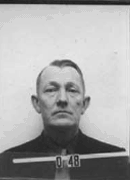Charles Lauritsen
Charles Christian Lauritsen (born April 4, 1892 in Holstebro , † April 3, 1968 ) was a Danish - American experimental physicist .
Lauritsen first studied architecture in Odense (graduated in 1911). He served in the Danish Army from 1911 to 1912 and from 1914 to 1915. In 1917 he went to the USA, where he initially designed ships and also worked as a fisherman in Florida. From 1919 to 1921 he was an engineer with the Ohio Body and Blower Company and from 1921 to 1923 radio engineer with the Federal Telegraph Company in Palo Alto , where he dealt with radio technology on ships. He then founded his own radio company in his garage and from 1923 to 1926 he was chief scientist at the Kennedy Radio Corporation in St. Louis. After hearing a lecture by Robert Millikan , he decided to become a physicist and began studying at Caltech, where he received his doctorate from Millikan in 1929 on cold field emission of electrons from metals, achieving good agreement with the theoretical work of Robert Oppenheimer . In the 1930s he built X-ray tubes (up to 750 keV) especially for medical applications (shortly afterwards taken over by the newly founded Kellogg Radiation Laboratory), for which he received the gold medal of the American College of Radiology in 1931. Then he turned to the construction of particle accelerators ( Cockcroft-Walton accelerator ) and their use in nuclear physics with HR Crane . In 1933 they demonstrated a simple way of generating neutrons (previously discovered by James Chadwick ), first by bombarding them with helium nuclei (alpha particles) and then with deuterium , and in 1934 they were the first to show that radioactive nuclei were also formed in the process (those of Carl D. Anderson generated positrons previously discovered in cosmic rays ). In 1930 he became an Assistant Professor, 1931 Associate Professor and 1935 Professor at Caltech , where he retired in 1962.
At Caltech, he was a pioneer in experimental nuclear physics in the 1930s. He was one of the first to demonstrate experimentally the pair annihilation of electron-positron pairs. He also worked closely with theorists such as Oppenheimer, Howard P. Robertson, and Richard C. Tolman in the 1930s . Lauritsen discovered, among other things, mirror nuclei, which Oppenheimer examined theoretically, which resulted in evidence of the charge independence of the nuclear forces, and the capture of protons in carbon nuclei, which later became important in astrophysics ( Bethe-Weizsäcker cycle 1939). As a result, research at Caltech was geared towards exploring the reactions that are important for nuclear astrophysics .
In 1951 he was president of the American Physical Society . From 1952 to 1957 he was a member of the Science Advisory Committee of the United States Office of Defense Mobilization, after he had already turned to military research in World War II, from 1940 as a member of the National Defense Research Committee in Washington, DC at the invitation of Tolman engaged in the development of fuses and missiles for artillery. From 1944 he was also at Oppenheimer's Manhattan Project . In 1948 he received the Medal of Merit from the US President for his war research. After the war he organized the research of the Office of Naval Research and advised the US Navy, but was also involved in several large research projects of the US military. For example, he traveled to Korea as a scientific observer during the Korean War and was an important advisory committee on military missile research in the USA.
In 1941 he became a member of the National Academy of Sciences . In 1967 he received the Tom W. Bonner Prize for Nuclear Physics . In 1939 he became a member of the Royal Danish Academy of Sciences and commander of the Dannebrog Order (1953).
William A. Fowler was one of his students .
His son Thomas Lauritsen (1915–1973) was also a well-known nuclear physicist.
literature
- William A. Fowler : Charles Christian Lauritsen 1892–1968. A Biographical Memoir. In: Biographical Memoirs of the National Academy of Sciences. 1975 ( PDF; 1.205 MB )
Web links
| personal data | |
|---|---|
| SURNAME | Lauritsen, Charles |
| ALTERNATIVE NAMES | Lauritsen, Charles Christian (full name) |
| BRIEF DESCRIPTION | Danish-American experimental nuclear physicist |
| DATE OF BIRTH | April 4, 1892 |
| PLACE OF BIRTH | Holstebro , Denmark |
| DATE OF DEATH | 3rd April 1968 |
